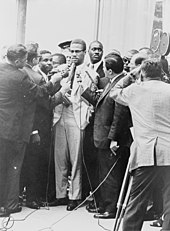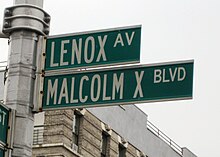Malcolm X
He subsequently embraced Sunni Islam and the civil rights movement after completing the Hajj to Mecca and became known as "el-Hajj Malik el-Shabazz", which roughly translates to "The Pilgrim Malcolm the Patriarch".
Hundreds of streets and schools in the U.S. have been renamed in his honor, while the Audubon Ballroom, the site of his assassination, was partly redeveloped in 2005 to accommodate the Malcolm X and Dr. Betty Shabazz Memorial and Educational Center.
[10] After a dispute with creditors, Louise received a life insurance benefit (nominally $1,000 —about $21,000 in 2024)[A] in payments of $18 per month;[11] the issuer of another, larger policy refused to pay, claiming her husband Earl had committed suicide.
[20][21] After a short time in Flint, Michigan, he moved to New York City's Harlem neighborhood in 1943, where he found employment on the New Haven Railroad and engaged in drug dealing, gambling, racketeering, robbery, and pimping.
[32] Summoned by the local draft board for military service in World War II in late 1943, he feigned mental disturbance by rambling and declaring: "I want to be sent down South.
[36] In 1946, he was arrested while picking up a stolen watch he had left at a shop for repairs,[37] and in February began serving a sentence of eight to ten years at Charlestown State Prison for larceny and breaking and entering.
[44] At this time, several of his siblings wrote to him about the Nation of Islam, a relatively new religious movement preaching Black self-reliance and, ultimately, the return of the African diaspora to Africa, where they would be free from White American and European domination.
[47] Following a visit during which Reginald detailed the group's teachings, including the notion that White people are considered devils, Malcolm initially struggled to accept this belief.
[53] In 1950, the FBI opened a file on Malcolm after he wrote a letter from prison to President Harry S. Truman expressing opposition to the Korean War and declaring himself a communist.
[70] One-on-one dates were contrary to the Nation's teachings, so the couple courted at social events with dozens or hundreds of others, and Malcolm X made a point of inviting her on the frequent group visits he led to New York City's museums and libraries.
These included beliefs: Louis E. Lomax said that "those who don't understand biblical prophecy wrongly label him as a racist and as a hate teacher, or as being anti-White or as teaching Black Supremacy".
[104] One of the goals of the civil rights movement was to end disenfranchisement of African Americans, but the Nation of Islam forbade its members from participating in voting and other aspects of the political process.
[108] During this period, he denounced Martin Luther King Jr. as a "chump," and referred to other civil rights leaders as being "stooges" of the White establishment and was strongly against any kind of racial integration.
[123] Malcolm X believed that the fabricated antisemitic text The Protocols of the Elders of Zion was authentic and introduced it to NOI members, while accusing the Jewish people of "perfecting the modern evil" of neo-colonialism.
[142] Over a series of national TV interviews between 1964 and 1965, Malcolm X provided testimony of his investigation, corroboration, and confirmation by Elijah Muhammed himself of multiple counts of child rape.
[152][153] On March 26, 1964, he briefly met Martin Luther King Jr. for the first and only time—and only long enough for photographs to be taken—in Washington, D.C., as both men attended the Senate's debate on the Civil Rights bill at the U.S. Capitol building.
[158][159] In April 1964, with financial help from his half-sister Ella Little-Collins, Malcolm X flew to Jeddah, Saudi Arabia, as the start of his Hajj, the pilgrimage to Mecca obligatory for every Muslim who is able to do so.
[163] Malcolm X later said that seeing Muslims of "all colors, from blue-eyed blonds to Black-skinned Africans," interacting as equals led him to see Islam as a means by which racial problems could be overcome.
[165] Malcolm X had already visited the United Arab Republic (a short-lived political union between Egypt and Syria), Sudan, Nigeria, and Ghana in 1959 to make arrangements for a tour of Africa by Elijah Muhammad.
[168] During these visits he met officials, gave interviews, and spoke on radio and television in Egypt, Ethiopia, Tanganyika, Nigeria, Ghana, Guinea, Sudan, Senegal, Liberia, Algeria and Morocco.
[170] By the end of this third visit, he had met with essentially all of Africa's prominent leaders;[171] Kwame Nkrumah of Ghana, Gamal Abdel Nasser of Egypt, and Ahmed Ben Bella of Algeria had all invited Malcolm X to serve in their governments.
The motion was taken from a statement made earlier that year by U.S. presidential candidate Barry Goldwater: "Extremism in the Defense of Liberty is No Vice; Moderation in the Pursuit of Justice is No Virtue".
"[211][212][213] As Malcolm X and his bodyguards tried to quell the disturbance,[M] a man rushed forward and shot him once in the chest with a sawed-off shotgun[214][215] and two other men charged the stage firing semi-automatic handguns.
[232] In 2021, Muhammad Abdul Aziz and Khalil Islam (formerly Norman 3X Butler and Thomas 15X Johnson) were exonerated from their murder convictions, following a review that found the FBI and the New York Police Department withheld key evidence during the trial.
[236] For the funeral on February 27, loudspeakers were set up for the overflow crowd outside Harlem's thousand-seat Faith Temple of the Church of God in Christ,[237][238] and a local television station carried the service live.
[237][240] Actor and activist Ossie Davis delivered the eulogy, describing Malcolm X as "our shining Black prince ... who didn't hesitate to die because he loved us so": There are those who will consider it their duty, as friends of the Negro people, to tell us to revile him, to flee, even from the presence of his memory, to save ourselves by writing him out of the history of our turbulent times.
"[248] The New York Times wrote that Malcolm X was "an extraordinary and twisted man" who "turn[ed] many true gifts to evil purpose" and that his life was "strangely and pitifully wasted.
If set in the context of the 1930s and 1940s, these acts position him not as a 'homosexual lover,' as has been asserted, but in the pattern of 'straight trade'—heterosexual men open to sex with homosexuals—an understanding that in turn affords insights into the Black revolutionary's mature masculinity.
[318][319][320] Many African Americans, especially those who lived in cities in the Northern and Western United States, felt that Malcolm X articulated their complaints concerning inequality better than did the mainstream civil rights movement.
[377] Arnold Perl and Marvin Worth attempted to create a drama film based on The Autobiography of Malcolm X, but when people close to the subject declined to talk to them they decided to make a documentary instead.












